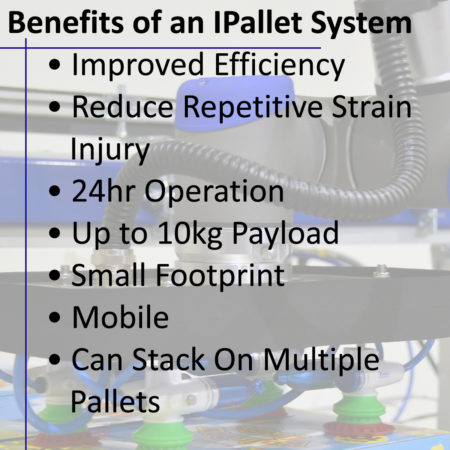
Benefits of our IPallet palletiser robots include safety, footprint and mobility, which sets this system apart.
The IPallet does not require fenced guarding around the unit, a standard system can take up as little as 2500 x 1500mm of space.
The collaborative robot (cobot) comes with a user friendly HMI that does not need programming by the operator. The software will store the various box orientations, box sizes, number of layers and rows, it only requires the operator to select the set up they need. A new App allows for easy programming to create a new layout.
It is critical that safety be at the forefront of the design and build, especially when you can create a system without the need for guarding/cages.
Firstly the cobot arm has force sensors that are located on all the joints. The sensors act to restrict the impact force when coming into contact with something or someone. A cushioned ‘halo’ around the gripper unit both protects the gripper head and whatever may knock into it.
It is important to understand that a force limited collaborative robot on it’s own is not sufficient to meet the requirements of EN ISO 10218, the harmonised safety standard used to achieve CE conformity for robotic applications. Even though the robot itself has a CE mark of conformity, this is merely an indication that the equipment is CE certified as a component part and not a complete system. An OEM such as ourselves have a responsibility to make sure the complete machine is designed and built to not only perform the required function, but that it does so safely within the scope of the machinery directive as a CE compliant machine. As such, additional safety features are generally required as a means to ensure the machine is fully compliant.
One solution is to add sensors at various points on the machine. The sensors detect movement, if something or someone is approaching the machine various functions can be put in place to determine what the machine is to do, like slow down, or completely stop. The video, towards the bottom of this page, shows a small sample of the innovative safety features our programming team put on our IPallet palletiser robots.
Whilst some processes will be very simple, for example; one sized box to be picked and placed onto one sized pallet. There will be many operations that will require picking a number of different sized boxes and placing them on different pallets.
The latter process will require the Palletiser to have a vision system fitted that can identify the box for it to be picked and placed on the correct pallet. Identification of the box can come from reading a barcode among other methods of recognition.
Our standard palletiser robots are mobile systems that can be easily moved and set up in a new area very quickly. The frame was designed to have the arms fold inwards to make it more compact for moving the unit. The IPallet accepts standard pallet trucks.
An optional vacuum pump integrated within the cobot offers more freedom in its mobility, there is no external compressed air required.
With a lifter on the arm, it can operate at high and low heights, giving it even more flexibility.